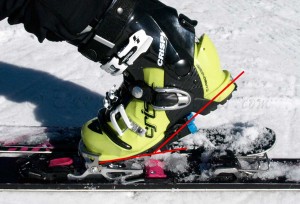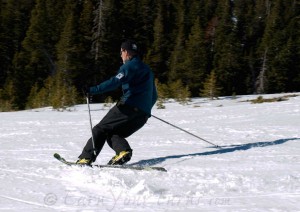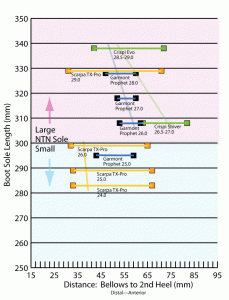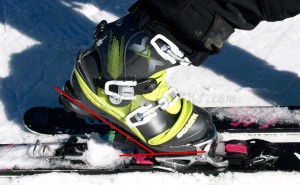Depending on what size boot you have, and the binding you pair it with, you may not be able to replicate the sweet tele flex you can get with the same size duckbilled boot. It also turns out, this is more noticeable with Garmont/Scott and Crispi brand boots than with Scarpa.
Flex comes from the sole
I first noticed this problem when testing Garmont’s Prophet with the NTN Freeride binding, almost five years ago. It wasn’t until I skied Crispi’s Shiver that I was convinced it was more than a minor aberration. With either boot, no matter how hard I tried to compress the bellows I couldn’t get adequate pressure on the balls of my feet. Instead, all the pressure was applied through my toes because the sole couldn’t flex as much behind the bellows. Both were size 26.5, with a large NTN sole.
With 75mm boots the sole is a consistent thickness in front of the heel and if a cable binding is used, tension is applied between the heel and toe. In the case of NTN, the boot is clamped between the toe and 2nd heel, aka the duckbutt. The presence of the duckbutt increases the thickness of the sole behind the bellows, potentially creating a discontinuity in the flex of the sole.
In any sized NTN boot the 2nd heel attachment yields superior lateral stiffness and better edging. However, there are only two NTN sole sizes, small and standard, for 8-9 different sized boots, 23-26.0 for the small sole, 26.5-30.5 for the standard. This means that the relative position of the bellows to the duckbutt is not consistent, and the resulting flex of boots is inconsistent.
The further the duckbutt is from the bellows, the more noticeable this issue is. It is unlikely I would ever have known this except that my foot size straddles the line where the sole size changes, which is also dead center in the bell shaped curve of foot sizes. Thus, with Scarpa I fit a size 26 with a small NTN sole, with Crispi and Garmont (now Scott), a 26.5 with a large NTN sole.
Measuring up
That there were dimensional differences between brands and sizes was not in dispute. It is possible that part of the issue is the overall sole stiffness of the Garmont and Crispi are more than Scarpa’s, and perhaps the asymmetric curve of Scarpa’s bellows makes flexing NTN boots easier. A simple review of the actual dimensions reinforces this.I spent an afternoon searching for NTN boots in Truckee and made the following measurements in the graph to the right. You can see that the distance from the middle of the bellows on the outside of the foot is universally the shortest distance between the bellows and 2nd heel. With Crispi and Garmont (now branded Scott, same molds though) this distance was always larger than for Scarpa. In fact, after actually measuring it is clear that Scarpa has designed their boots to have a consistent dimension between the bellows and 2nd heel, regardless of size.
Confirming the sensation
Before I undertook that pesky accounting task though, I needed independent corroboration of the experience while skiing. A quick call to Jason Layh, instructor and coach of the Alpine Meadows kids tele team almost burst my bubble, because he thought his TX-Pros, size 27 with a large NTN sole, skied awesome. It is worth noting, he can ski anything so I couldn’t rely on that opinion alone. However, he had experienced the flex problem with Crispi and Garmont boots. He concluded it was a design flaw resulting from simply adding the duckbutt to a 75mm mold.Next I enlisted the help of a relative stranger, JFB from the BCTalk forum. He’s a Tahoe regular, with the same size foot. We met at Sugar Bowl’s Judah parking lot and skied for about four hours with one foot wearing a Scarpa TX-Pro, size 26.0 with a small NTN sole, the other a Crispi Shiver size. 26.5 with a large.
To be sure, this is a subtle phenomenon, but noticeable nonetheless. JLB noticed the difference in stiffness immediately. It took a second run to notice the pressure was more on his toes, but he thought with practice he might adapt and fail to notice it. On the other hand, if he could flex the boots easier and drive pressure through the ball of the foot, as he could with the shorter NTN sole on the Scarpa boot, that would be preferred. As the day progressed, that opinion was only reinforced.
Contrast that with another friend, a former PSIA telemark examiner, using the Crisp Evo in a size 28.5 (BSL 328mm), who says the boots flexed great, with good pressure on his mets and the stiffest/best flexing tele boot he has skied in the last three years. However, if my theory was correct, his foot was large enough it shouldn’t matter.
Scope of the problem

Compared to Scarpa’s TX, the Crispi Shiver has a higher angle from the bellows forward resulting in tele pressure shifting forward of the metatarsals. CTE
It is also worth noting that the dead spot in the sole is more evident when using the TTS binding with the cable tension applied at the heel, than it is when using the NTN Freedom with cable tension at the second heel. I think part of that is due to the reverse ramp angle in the Freedom toe plate.
Whether or not this is a problem depends on whether you’re using a boot that might exhibit this phenomenon, and can you even tell. In other words, ignorance may be bliss but I lean on the side of empirical results that if a boot prevents you from flexing properly at the ball of the foot, telemark power and control will inevitably suffer. The sole is undeniably thicker and stiffer as the result of the 2nd heel. The further this is from the bellows, the more pronounced the sole stiffness. For big guys, wanting burly performance this is a great benefit. Except, generally, big guys have bigger feet and the problem doesn’t exist for size 27.5 and larger, only for 26.5 with the large NTN sole, and size 24.5 or smaller.
Resolving the issue
The solution seems obvious. Remove the dead spot behind the bellows. There are any number of solutions, but my guess is Crispi will wait until Scott changes their molds so the Voodoo NTN skis more like a Scarpa, and then they will too. For the sake of small feet one might dream of a third NTN sole size being created, but that will certainly not happen until interest in telemark skiing picks up, and with it a dramatic increase in equipment sales. If that matters to you, speak up and ask for it. I’m asking, but also wonder if the moon will be colonized before that happens.
© 2014




5 comments
Skip to comment form
Thanks for explaining this, helps explain why I never have been able to really like skiing NTN and for me, this statement rings true: “you may not be able to replicate the sweet tele flex you can get with the same size duckbilled boot.” It is a combination of not having enough ball of foot contact AND the dead zone at the start of the turn. My foot straddles the size break too and I started NTN with a performance fit TX Pro in 26, which was too small so I needed to get both new boots (27s) and new, larger Freedoms (ouch) so I too would love a third NTN sole size. Moot point for me now since I am back to my beloved Axls and (less loved) duckbills but plan to try again when the 22Designs NTN is released.
I haven’t experienced this issue and love the way NTN skis. But I’m on large 28.0 TX Pros with Freedom bindings.
Interesting I can only speak from personal experience. My tele which was serviceable before NTN is more fluid now. Part of that is 7-years of NTN familiarity but mostly I believe because I am skiing the Freedom currently instead of the Freeride. I wear a 25.5 and the small binding. That falls into the sweet spot the author mentioned. Hmmm. Maybe the NTN system really needs 4 or 5 binding sizes instead of two with gradations of a centimeter every few sizes–toe to duckbutt.
One caveat, I use a 4mm plate under the Freedom heel to give me the same flt heel/toe plane and forward lean I get on my alpine setups.
You’re comparing pictures of a very soft Tx vs a stiffer Shiver… it’s obvious that the Tx will bend easily at the bellow !!
But I own both boots (old versions), and the Shiver is a lot more powerful than the Tx, no matter where and how it bends, and both feel right for what they are designed to do.
Bringing up a really old thread for an even older topic here, but I found this when I was trying to figure out something I’d noticed about my Hammerheads recently.
So I’d noticed the Hammerheads had 22mm clearance and my 75mm duckbill has ~18mm thickness, so when I put it down, I get the toe rise similar to to the Crispi Shiver picture you’ve got there. I have to be really conscious when skiing it not to let my toe lift in the extra clearance (unlike, say, in my BD 02s or my G3 Targas…yes I have an old quiver), and have to set the Hammerheads to 4 or 5 in order to not just immediately lift up when I ski with a heavy stiff boot (Scarpa T1 or BD Custom).
Any thoughts on this? I really can’t find much discussion of the extra toe clearance in the Hammerhead anywhere online these days, as while it used to be the gold standard I can’t find many people who’ve held on to theirs.